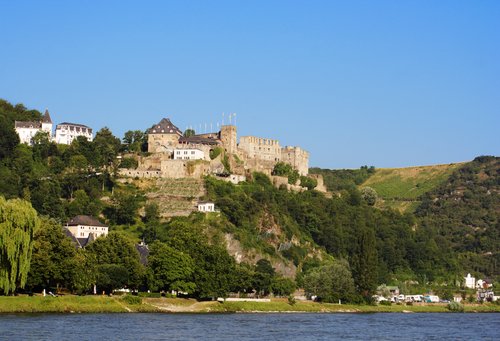AGENDA:
1. Breafest
2. In the morning Rhine River Curse
3. Lunch at St. Goar
4. Visit Rheinfels Castle
5. Tour Eltz Castle
6. Take train back to Bacharach for the night
RHINE RIVER CURSE
The Rhine is one of the longest and most important rivers in Europe, at 1,320 km (820 mi), with an average discharge of more than 2,000 m3/s (71,000 cu ft/s). The name of the Rhine derives from Gaulish Renos, and ultimately from the Proto-Indo-Eruopean root *reie- ("to move, flow, run"), which is also the root of words like river and run. The Rhine and the Danube formed most of the northern inland frontier of the Roman Empire and, since those days, the Rhine has been a vital, navigable waterway, and carried trade and goods deep inland. It has also served as a defensive feature and has been the basis for regional and international borders. The many castles and prehistoric fortifications along the Rhine testify to its importance as a waterway. River traffic could be stopped at these locations, usually for the purpose of collecting tolls, by the state that controlled that portion of the river.
We will cruse the best and most scientci part of the rhine river (a thirty mile streach from Bacharach north to St. Goar).
RHEINFELS CASTLE

Burg Rheinfels is a castle ruin located in Sankt Goar, overlooking the Rhine river. It was started in 1245 by Count Diether V of Katzenelnbogen and was partially destroyed by French Revolutionary Army troops in 1797. It is the largest castle overlooking the Rhine, and historically covered five times its current area.
BURG ELTZ

 Lurking in a mysterious forest, it's been left intact for 700 years and is furnished throughout much as it was 500 years ago. Thanks to smart diplomacy and clever marriages, Burg Eltz was never destroyed. It's been in the Eltz family for 850 years. Elz is the name of a stream that runs past the castle through a deep valley before emptying into the Mosel. The first record of a Burg (castle) on the Elz is from 1157, built to protect a trade route. By 1472 the castle looked like it does today: the homes of three big landlord families gathered around a tiny courtyard within one formidable fortification. Today, the excellent 45-minute tours wind you through two of those homes while the third remains the fortified quarters of the Eltz family. The elderly countess of Eltz — whose family goes back 33 generations here (you'll see a photo of her family) — enjoys flowers. Each week for 40 years she's had grand arrangements adorn the public castle rooms. It was a comfortable castle for its day: 80 rooms made cozy by 40 fireplaces and wall-hanging tapestries. Many of its 20 toilets were automatically flushed by a rain drain. The delightful chapel is on a lower floor. Even though "no one should live above God," this chapel's placement was acceptable because it filled a bay window, which flooded the delicate Gothic space with light. The three families met — working out common problems as if sharing a condo — in the large "conference room." A carved jester and a rose look down on the big table, reminding those who gathered that they were free to discuss anything ("fool's freedom" — jesters could say anything to the king), but nothing discussed could leave the room (the "rose of silence").
Lurking in a mysterious forest, it's been left intact for 700 years and is furnished throughout much as it was 500 years ago. Thanks to smart diplomacy and clever marriages, Burg Eltz was never destroyed. It's been in the Eltz family for 850 years. Elz is the name of a stream that runs past the castle through a deep valley before emptying into the Mosel. The first record of a Burg (castle) on the Elz is from 1157, built to protect a trade route. By 1472 the castle looked like it does today: the homes of three big landlord families gathered around a tiny courtyard within one formidable fortification. Today, the excellent 45-minute tours wind you through two of those homes while the third remains the fortified quarters of the Eltz family. The elderly countess of Eltz — whose family goes back 33 generations here (you'll see a photo of her family) — enjoys flowers. Each week for 40 years she's had grand arrangements adorn the public castle rooms. It was a comfortable castle for its day: 80 rooms made cozy by 40 fireplaces and wall-hanging tapestries. Many of its 20 toilets were automatically flushed by a rain drain. The delightful chapel is on a lower floor. Even though "no one should live above God," this chapel's placement was acceptable because it filled a bay window, which flooded the delicate Gothic space with light. The three families met — working out common problems as if sharing a condo — in the large "conference room." A carved jester and a rose look down on the big table, reminding those who gathered that they were free to discuss anything ("fool's freedom" — jesters could say anything to the king), but nothing discussed could leave the room (the "rose of silence").
